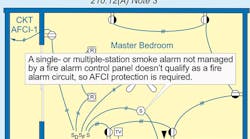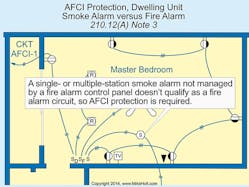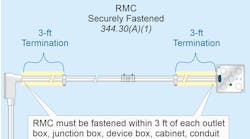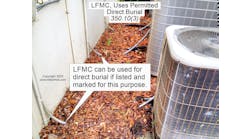Q. Where does the 2014 NEC require arc-fault circuit-interrupter protection?
Find the Answer
A. Arc-fault circuit-interrupter (AFCI) protection must be provided in accordance with Sec. 210.12(A), (B) and (C). AFCI devices must be installed in readily accessible locations.
(A) All 15A or 20A, 120V branch circuits in dwelling units supplying outlets or devices in kitchens, family rooms, dining rooms, living rooms, parlors, libraries, dens, bedrooms, sunrooms, recreation rooms, closets, hallways, laundry areas, or similar rooms or areas must be protected by one of the following [210.12(A)] :
(1) A listed combination type AFCI, installed to provide protection of the entire branch circuit.
(2) A listed branch/feeder type AFCI at the origin of the branch circuit, plus a listed outlet branch-circuit AFCI installed at the first outlet box of the branch circuit. The outlet box must be marked to indicate that it’s the first outlet box of the circuit.
(3) A listed supplemental arc protection circuit breaker installed at the origin of the branch circuit, plus a listed outlet branch-circuit type AFCI installed at the first outlet box on the branch circuit. When using this option, the following must be met:
(a) The branch-circuit wiring must be continuous from the branch circuit overcurrent device to the AFCI device.
(b) The maximum length of the branch circuit to the AFCI is 50 ft for 14 AWG conductors or 70 ft for 12 AWG conductors.
(c) The first outlet box in the circuit must be marked.
(4) A regular fuse or circuit breaker, plus a listed outlet branch-circuit type AFCI installed at the first outlet of the branch circuit. When using this option, the following must be met:
(a) The branch-circuit wiring must be continuous from the branch-circuit overcurrent device to the AFCI device.
(b) The maximum length of the branch circuit to the AFCI is 50 ft for 14 AWG conductors or 70 ft for 12 AWG conductors.
(c) The first outlet box in the circuit must be marked.
(d) The combination of the branch-circuit overcurrent device and the AFCI must be listed and identified as meeting the requirements for a “System Combination” type AFCI.
(5) A listed outlet branch-circuit type AFCI at the first outlet can be used, if the wiring between the overcurrent device and the AFCI contains all metal boxes and is installed using any (or a combination) of the following: RMC, IMC, EMT, Type MC, Type AC cables meeting the requirements of Sec. 250.118, metal wireways, or metal auxiliary gutters.
(6) A listed outlet branch-circuit type AFCI at the first outlet of the circuit can be used, if the wiring between the overcurrent device and the AFCI is in a raceway with 2 in. of concrete encasement.
Author’s Comment: The combination AFCI is a circuit breaker that protects downstream branch-circuit wiring as well as cord sets and power-supply cords; an outlet branch-circuit AFCI (receptacle) is installed as the first outlet in a branch circuit to protect downstream branch-circuit wiring, cord sets, and power-supply cords.
The 120V circuit limitation means AFCI protection isn’t required for equipment rated 230V, such as a baseboard heater or room air conditioner. For more information, visit www.MikeHolt.com, click on the “Search” link, and then search for “AFCI.”
Exception: AFCI protection can be omitted for an individual branch circuit to a fire alarm system in accordance with Sec. 760.41(B) and Sec. 760.121(B), if the circuit conductors are installed in metal wireways, metal auxiliary gutters, RMC, IMC, EMT, or steel sheath Type AC or MC cable that qualifies as an equipment grounding conductor in accordance with Sec. 250.118, with metal outlet and junction boxes.
Informational Note 3: See Sec. 760.41(B) and Sec. 760.121(B) for power-supply requirements for fire alarm systems.
Author’s Comment: Smoke alarms connected to a 15A or 20A circuit in a dwelling unit must be AFCI protected if the smoke alarm is located in one of the areas specified in Sec. 210.12(A). The exemption from AFCI protection for the “fire alarm circuit” contained in Sec. 760.41(B) and Sec. 760.121(B) doesn’t apply to the single- or multiple-station smoke alarm circuit typically installed in dwelling unit bedroom areas. This is because a smoke alarm circuit isn’t a fire alarm circuit as defined in NFPA 72, National Fire Alarm Code. Unlike single- or multiple-station smoke alarms, fire alarm systems are managed by a fire alarm control panel.
(B) Branch-Circuit Extensions or Modifications — Dwelling Units. Where branch-circuit wiring is modified, replaced, or extended in any of the areas specified in Sec. 210.12(A), the branch circuit must be protected by:
(1) A listed combination AFCI located at the origin of the branch circuit; or
(2) A listed outlet branch circuit AFCI located at the first receptacle outlet of the existing branch circuit.
Exception: AFCI protection isn’t required for extensions less than 6 ft long, as long as there are no outlets or devices added.
(C) Dormitory Units. All 120V, single phase, 15A and 20A branch circuits supplying outlets installed in dormitory unit bedrooms, living rooms, hallways, closets, and similar rooms must be AFCI protected by one of the methods discussed in Sec. 210.12(A)(1) through (6).
These materials are provided to us by Mike Holt Enterprises in Leesburg, Fla. To view Code training materials offered by this company, visit www.mikeholt.com/code






